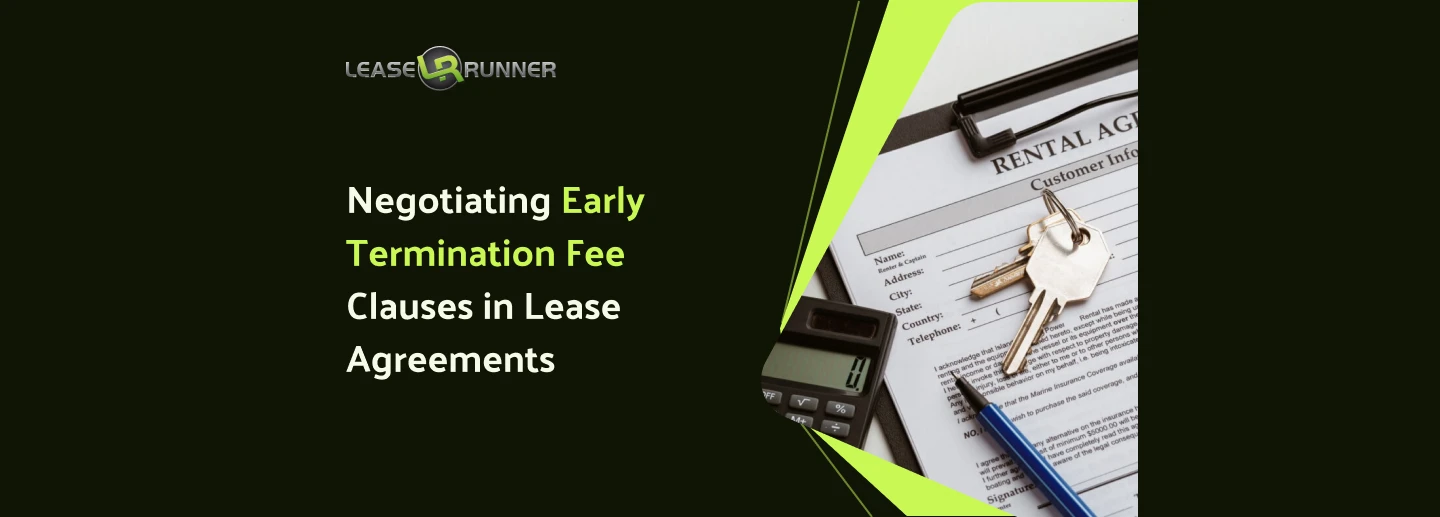When it comes to understanding the early termination fee (ETF), both landlords and tenants need clear insights into how this term impacts lease agreements. An early termination fee is a monetary charge a tenant may owe if they decide to end their lease before its agreed-upon expiration date.
This fee protects landlords from financial loss caused by unexpected vacancies and helps tenants understand the cost implications of leaving early. In our experience at LeaseRunner, carefully drafting and negotiating these clauses can prevent misunderstanding and conflict between parties.

What Is an Early Termination Fee?
An early termination fee is a lease clause that requires tenants to pay a penalty if they terminate their lease prematurely. This fee is established to compensate landlords for lost income during vacancy periods, lost rent, and re-leasing costs.
It is important to understand what an early termination fee is prior to signing any lease, as it will have a direct connection to a tenant's financial obligation if they need to leave early.
Typically, this fee compensation is made up of:
- Unpaid rent until a subsequent tenant is secured
- Administrative charges associated with re-leasing
- Potential loss of rental income
The lease provision for early termination outlines the particulars, such as the timing for tenants to reach out to landlords and how the fee is calculated. For example, an early termination fee might be equivalent to two months' rent or a flat fee predetermined in the rental agreement.
A reasonable early termination fee balances protecting the landlord’s interests without unfairly burdening tenants. The intent is not to punish but to cover tangible losses. Through LeaseRunner's guidance on writing a lease termination letter here, tenants can negotiate fair terms or understand when fees might be waived due to special conditions, such as job transfers or health issues.
What to Include in an Early Termination Clause?

Setting clear terms in a lease early termination fee clause is essential for both parties. This clause should outline expectations around the process and fees involved. Here are critical components:
1. Notice Requirements
A key aspect is how much notice a tenant must give. Typically, leases stipulate 30 to 60 days’ written notice before early termination. This gives landlords the essential notice period to find new tenants and minimize losses.
The 30-day notice to vacate (or any other types of notice) should specify the address and method for delivery, helping both sides document communication clearly.
2. Termination Fees or Penalties
The specific amount or formula for the early termination fee must be stated. This can be a fixed sum (e.g., one month’s rent) or a sliding scale based on how early the lease ends. It might also include additional costs like advertising or screening new tenants.
3. Conditions for Early Termination
The clause may enumerate relevant reasons for lease early termination with no penalty (e.g., because of military deployment, domestic violence, or a major job relocation), and defining these exceptions helps a tenant understand when they are or are not liable to pay the termination fee.
4. Responsibilities Until Termination Date
Tenants usually need to keep paying rent and for utilities until the lease terminates, or a new tenant moves in. This section reiterates that obligations will continue throughout the notice period.
5. Landlord's Right to Re-let
This section provides that the landlord must reasonably attempt to re-rent the unit as soon as possible to minimize their damages from early termination. Tenants should be aware of their landlord's obligation to stop charging fees once the unit is re-rented.
6. Effective Termination Date
It should be clear when the termination becomes effective, the last day of the notice period, or when a new tenant moves in. Clarity of dates will readily resolve disputes regarding the tenant’s obligation to pay rent or fees.
7. Return of Security Deposit
The clause may explain how the security deposit is handled when a lease ends early, including deductions for unpaid fees, damages, or other charges.
For example, an early termination fee for an apartment lease might include these components explicitly, ensuring clarity for tenants and reducing conflict.
How Much Is an Early Termination Fee?

Wondering how much an early termination fee is a common question. Typically, this fee ranges from 1 to 2 to 4 months’ rent, but it varies based on the lease terms, local laws, and market conditions. In some cases, a flat dollar amount may be set regardless of rent.
Landlords often anchor the fee to their probable financial loss, such as lost rent and costs to secure a new tenant. A fee equal to two months’ rent is common and is often seen as a reasonable early termination fee.
In some markets, statutes limit how much landlords can charge to avoid excessive penalties. LeaseRunner advises tenants to carefully review these clauses and negotiate terms where possible to avoid surprise costs.
When Can Tenants Legally Terminate Their Lease Early?
Tenants might ask, “Can tenants terminate a lease early?”, and if so, under what legal grounds? Generally, tenants are bound by the lease term but may terminate early if:
- The landlord violates lease terms (e.g., failure to maintain the property)
- They face situations like military duty, domestic violence, or health emergencies (as protected by law)
- There is mutual agreement with the landlord on termination conditions
- They pay any early termination fee, lease, or penalties required
Understanding tenant early termination of lease agreement rights is essential, and tenants can find detailed guidance on legally ending leases early through resources like LeaseRunner’s blog on how to get out of a lease early.
Tenant’s Rights: What Happens if They Break the Lease?
Breaking a lease and facing an early termination fee can have legal and financial consequences. Tenants must be aware of their rights and obligations after deciding to terminate early:
- They usually owe the early termination fee plus rent until the landlord finds a new tenant
- The landlord must mitigate damages by trying to re-rent promptly
- Failure to pay fees can lead to legal actions, such as paying rent late fees, filing claims, or reporting to credit agencies
For tenants worried about credit repercussions, LeaseRunner explains in detail whether breaking a lease hurts your credit.
How to Avoid Conflicts During Negotiations for Landlords?

Preventing disputes over early termination fee clauses is important for good landlord-tenant relationships. Landlords can use these steps to handle negotiations about early termination fee lease terms smoothly and fairly.
1. Approach the Discussion with Empathy and Professionalism
Start by understanding the tenant’s situation. A tenant may need to move early due to a job change or family emergency. Listening carefully and showing empathy builds trust. For example, landlords who calmly discuss the tenant’s needs often find tenants are more willing to cooperate than if they feel judged or pressured.
2. Clearly Explain Policies and Consequences
Make sure tenants know what is an early termination fee and what it means for them. Explain how much the fee is and why it exists. For instance, telling tenants that the early termination fee for an apartment lease helps cover lost rent and advertising costs prevents surprises. Clear communication avoids misunderstandings.
3. Offer Reasonable and Fair Terms
Landlords should base fee amounts on real costs, not punishment. A fee equal to one or two months’ rent usually balances fairness. For example, offering a discount if the tenant helps find a replacement is fair and encourages cooperation.
4. Explore Alternatives to Fees
Sometimes, alternatives work better than strict fees. Landlords may accept a partial fee waiver if a new tenant is found quickly. Or they might allow a tenant to assign the lease to someone else. This flexibility reduces tensions during the tenant's early termination of the lease agreement.
5. Focus on Win-Win Outcomes
The aim is to find solutions which benefit both sides. For example, landlords keep additional rental income flowing and tenants avoid financial penalties that are generally quite large. Finding win-win solutions generates goodwill and possible long-term loyalty from the tenant.
6. Put Agreements in Writing
Always document any negotiated changes in writing. Signed agreements prevent future disputes. For example, if a landlord agrees to waive part of the early termination fee, the tenant should receive a written confirmation outlining the new terms.
7. Plan for Re-renting Quickly
A fast re-let lowers losses and early termination fee risks. Landlords should start advertising the unit as soon as they know about the early move-out.
8. Be Open to Negotiation and Compromise
Flexibility helps close deals. For example, landlords could reduce the fee if tenants can move out within 30 days or refer a qualified replacement tenant.
By following these strategies, landlords can reduce conflict during lease clause for early termination talks and maintain good tenant relations while protecting their investment.
Legal Actions Landlords Can Take if the Fee is Unpaid

When tenants do not pay the early termination fee, landlords have several legal steps they can follow to recover the money owed. These actions help landlords enforce the early termination fee lease terms and protect their income.
1. Seek Payment Through Formal Demand
The first step is to send a formal written demand letter. This letter explains the amount owed, including any early termination fee for apartment lease charges, and requests immediate payment. For example, a landlord may mail or email this letter stating that if the fee is not paid by a certain date, further action will be taken. This official notice often prompts tenants to pay quickly to avoid more trouble.
2. Withhold or Forfeit Security Deposit
If the tenant still does not pay, landlords may keep part or all of the security deposit to cover the unpaid early termination fee. For example, if the tenant paid a $1,500 deposit but owes a $1,200 termination fee, the landlord can apply this deposit to the fee. However, this only works if the lease allows using the deposit for unpaid fees beyond property damage.
3. File a Small Claims Lawsuit
When informal methods fail, landlords can sue tenants in small claims court. This step is useful if the unpaid early termination fee is substantial or when the security deposit does not cover the amount. For instance, a landlord may file a claim for $3,000 after a tenant broke the lease early without paying the fee. Courts usually handle these cases quickly without the need for expensive lawyers.
4. Eviction Proceedings for Non-Payment
If the tenant stays in the property while owing the fee and rent, landlords may begin eviction proceedings, and the required eviction timeline is often different between states. Although this is a last resort, it’s a legal way to remove tenants who refuse to pay or leave. For example, a landlord might start eviction if the tenant neither pays the early termination fee nor moves out on time.
5. Charge Interest or Late Fees
Some lease agreements allow landlords to add interest or late fees to overdue balances. For example, a lease may say that a 5% monthly late charge applies to unpaid termination fees after 10 days past due. This added cost encourages tenants to pay on time.
6. Report to Credit Bureaus or Collections
Finally, landlords can report unpaid fees to credit bureaus or collections agencies. This action can damage tenants’ credit scores, motivating them to settle their debts. For example, if a tenant owes a large early termination fee on a lease and does not respond to demands, the landlord may transfer the debt to a collection company.
These legal actions help landlords enforce their rights under the lease clause for early termination and recover fees fairly. Tenants should understand that failing to pay the early termination fee can have serious financial and legal consequences.
Early Termination Buy-Out Options and Fees

Some leases include a buy-out option. This lets tenants pay a set fee to end the lease early without extra costs or penalties. The early termination buy-out option gives tenants a simple way to leave. It also helps landlords get paid fairly without delay.
What Is a Buy-Out Option in Lease Agreements?
A buy-out option means tenants can pay a fixed amount or use a clear formula to end their lease anytime. For example, a lease could say a tenant can pay a fee equal to two months’ rent as their early termination fee. If they pay this, they can move out without owing more money. This makes it easier for tenants who need flexibility and gives landlords certainty they won’t lose rent.
What to Include in a Buy-Out Clause?
It is important that the buy-out clause covers the following:
- Exact buy-out price or how to calculate it: Some leases fix the fee at a set number of months’ rent, like one or two months. Others use a sliding scale where the fee gets smaller the longer the tenant stays.
- Notice period needed: Tenants usually must tell landlords 30 to 60 days before they want to end the lease through buy-out. This gives landlords time to find a new tenant and lowers their losses.
- Effect on security deposit and fees: The clause should explain if the tenant’s security deposit will be fully returned after paying the buy-out fee or if parts are kept for damages or unpaid rent.
- Tenant duties until lease end: Even after paying the buy-out fee, tenants must often pay rent and take care of the property until their lease ends.
For example, in an early termination fee for an apartment lease, a tenant might notify the landlord 45 days ahead and pay a set fee equal to one and a half times the monthly rent. Then, they can leave without facing extra charges. The landlord can begin looking for new tenants immediately.
This buy-out option is ideal for tenants needing freedom to move on short notice. It also benefits landlords who want clear terms and prompt payment in place of uncertain fees from tenant early termination of lease agreement cases. It helps simplify negotiations about how much an early termination fee is and avoids disputes over fees later.
Conclusion
The early termination fee is a critical part of many lease agreements, affecting both landlords and tenants. By understanding what an early termination fee is, its components, and how it works in context, parties can negotiate terms that protect everyone's interests. Tenants should know how much an early termination fee they might owe, when they can legally end leases early, and their responsibilities regarding fees.
Landlords should approach fee negotiations with clarity, empathy, and fairness while enforcing payments through appropriate legal channels if necessary. LeaseRunner is committed to helping landlords and tenants navigate these complexities with clear guidance and practical resources for successful lease management.
FAQs
Can I Use the Security Deposit to Cover the Early Termination Fee?
Yes, landlords often retain the security deposit to cover unpaid early termination fee charges, provided this is specified in the lease agreement.
Do I Have to Pay an Early Termination Fee?
Yes. If the lease contains a valid early termination fee clause, tenants generally must pay it unless waived by the landlord or allowed by law.
How Much Is the AT&T Early Termination Fee?
The AT&T early termination fee usually ranges from $150 to $325, though the exact amount is a prorated charge that decreases over your contract term. For example, if you cancel a phone plan early, you might owe up to $325, but the fee can decrease over time as you pay down your device balance. This fee applies only to AT&T phone contracts and is not related to rental leases.
What Does Mitigating Damages Mean for Landlords?
Mitigating damages means landlords must make reasonable efforts to re-rent the property to reduce the financial impact when a tenant terminates early.
Can Tenants Terminate Lease Early?
Yes, they can. Tenants can terminate early under lease terms or legal exceptions, often paying an early termination fee or following a negotiated agreement.







